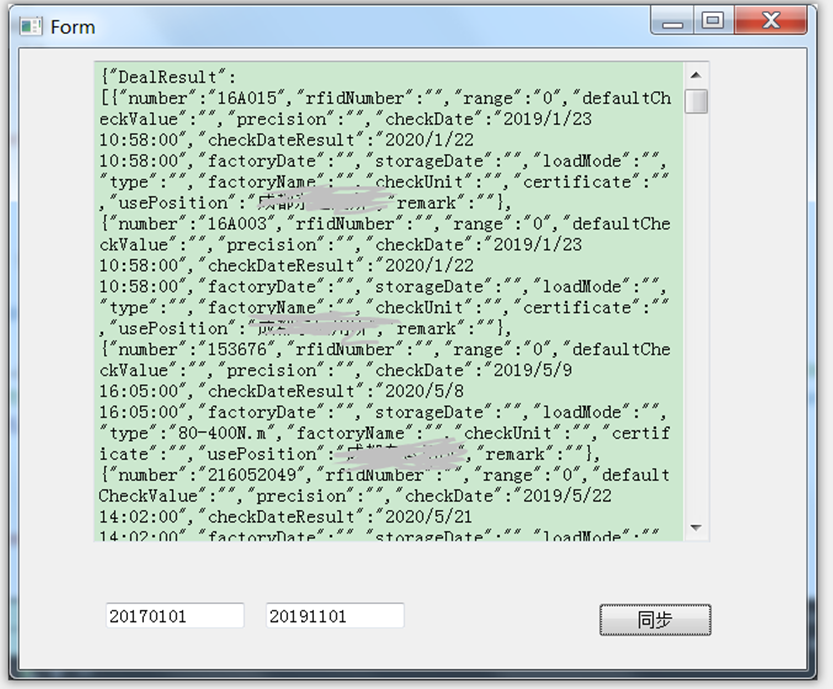由于当前C++项目需要使用ajax库去post调用ashx接口,接口地址如下所示:

需要传递的参数如下:

然后发现qml比较好调用ajax.js库,所以本章通过C++界面去获取qml方法来实现调用ashx接口(以一个C++界面demo程序为例)
1.抓post数据
通过网页获取到的post数据如下所示:

所以查询20191121~20191122期间时则填入内容: "deptCode=021&startDate=20191121&endDate=20191122"
2.导入ajax.js库
ajax.js文件如下所示:
// GET function get(url, success, failure) { var xhr = new XMLHttpRequest; xhr.open("GET", url); xhr.onreadystatechange = function() { handleResponse(xhr, success, failure); } xhr.send(); } // POST function post(url, arg, success, failure) { var xhr = new XMLHttpRequest; xhr.open("POST", url); xhr.setRequestHeader("Content-Length", arg.length); xhr.setRequestHeader("Content-Type", "application/x-www-form-urlencoded;"); //用POST的时候一定要有这句 xhr.onreadystatechange = function() { handleResponse(xhr, success, failure); } xhr.send(arg); } // 处理返回值 function handleResponse(xhr, success, failure){ if (xhr.readyState == XMLHttpRequest.DONE) { if (xhr.status == 200){ if (success != null && success != undefined) { var result = xhr.responseText; try{ success(result, JSON.parse(result)); }catch(e){ success(result, {}); } } } else{ if (failure != null && failure != undefined) failure(xhr.responseText, xhr.status); } } }
3.写main.qml
import QtQuick 2.3 import QtQuick.Window 2.2 import "ajax.js" as Ajax Item { function getWrenchTools(deptCode,startDate,endDate) { console.log("Got message:", deptCode,startDate,endDate) //打印参数数据 Ajax.post("http://10.194.102.253/WLPTService/Pages/Tools/GetNLToolsByDeptCode.ashx","deptCode="+deptCode+"&startDate="+startDate+"&endDate="+endDate+"", Widget.invokeFunc); }
这里表示定义一个getWrenchTools()方法,当post成功并返回数据时,则调用Widget.invokeFunc()回调函数(Widget: 该qml对应的C++类,后面会讲怎么捆绑的)
4.widget界面如下

然后写widget.h
#ifndef WIDGET_H #define WIDGET_H #include <QWidget> #include <QString> #include <QDebug> #include <QTimer> #include <QQmlApplicationEngine> #include <QQmlComponent> namespace Ui { class widget; } class widget : public QWidget { Q_OBJECT QQmlApplicationEngine engine; QObject *engineObject; //指向运行的qml对象 public: explicit widget(QWidget *parent = 0); ~widget(); private: Ui::widget *ui; public: Q_INVOKABLE void invokeFunc(QVariant data1,QVariant data2); private slots: void on_pushButton_clicked(); }; #endif // WIDGET_H
写widget.cpp
#include "widget.h" #include "ui_widget.h" #include <QTimer> #include <QQmlContext> widget::widget(QWidget *parent) : QWidget(parent), ui(new Ui::widget) { ui->setupUi(this); engine.rootContext()->setContextProperty("Widget",this); //将QML中的Widget变量指向为当前类.从而使QML和widget类连接起来 engineObject = QQmlComponent(&engine, "qrc:/main.qml").create(); //创建qml并获取运行中的qml对象 } widget::~widget() { delete ui; } void widget::invokeFunc(QVariant data1,QVariant data2) { ui->plainTextEdit->setPlainText(data1.toString()); } void widget::on_pushButton_clicked() { QVariant depatment= "021"; QVariant start= ui->start->text(); QVariant end = ui->end->text(); //"结束日期" QMetaObject::invokeMethod(engineObject, "getWrenchTools",Q_ARG(QVariant, depatment) ,Q_ARG(QVariant, start),Q_ARG(QVariant, end)); }
- engine.rootContext()->setContextProperty("Widget",this)的作用:
将QML中的Widget变量指向为当前类.从而使QML和widget类连接起来, 然后main.qml如果post成功则调用当前类的invokeFunc(QVariant data1,QVariant data2)方法,从而实现数据返回.
- 当按下同步按钮时,则调用on_pushButton_clicked():
由于engineObject指向运行中的qml对象,然后我们通过invokeMethod()就可以方便的请求调用qml对象中的getWrenchTools()函数.从而实现post请求
点击同步后,效果如下所示(然后可以参考50.Qt-QJsonDocument读写json来提取数据):

注意-如果出现QQmlComponent: Component is not ready字段,说明qml和js所在路径不在界面文件夹里
创建文件的时候,就需要将文件都放在界面目录中,才行:
